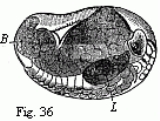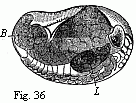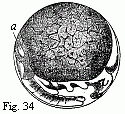
Embryons desséchés
Encyclopedia
Embryons desséchés is a piano composition by Erik Satie
, composed in the summer of 1913. The composition consists of three little "movements", each taking about two to three minutes to play.
1. (Desiccated embryo) of a Holothurian (30 June 1913), dedicated to Suzanne Roux:
2. (Desiccated embryo) of an Edriophthalma (1 July 1913), dedicated to Edouard Dreyfus:
3. (Desiccated embryo) of a Podophthalma (4 July 1913), dedicated to Jane Mortier:
orchestrated Embryons desséchés for a 1970 recording of Satie's orchestral music (CE 31018) by his ensemble, "Die Reihe." This performance of Embryons desséchés features an actress reciting the narratives from Satie's original score synchronously with the music, even though the composer disapproved of such a practice.
class of the Crustacea subphylum
of the Arthropoda phylum: the use of the terms Edriophthalmata and Podophthalmia became obsolete with regard to the taxonomy of crustaceans.
As to the sources Satie might have had to make references to Podophthalmia and Edriophthalmata: in early evolutionary biology these crustaceans (and notably also their embryos) were studied by Fritz Müller
, in his book Facts and Arguments for Darwin, published in German in 1863, and available in English in 1869. The images below are taken from the Project Gutenberg
publication of that book (E-text N° 6475):
The book also shows other development stages of these animals (zoea, larva
), even odder in shape.
Erik Satie
Éric Alfred Leslie Satie was a French composer and pianist. Satie was a colourful figure in the early 20th century Parisian avant-garde...
, composed in the summer of 1913. The composition consists of three little "movements", each taking about two to three minutes to play.
The music
The parts of the composition are:1. (Desiccated embryo) of a Holothurian (30 June 1913), dedicated to Suzanne Roux:
- See: sea cucumber. Note that this type of animal has no eyes.
- The music of this first part of the composition concentrates on the so-called "purrPurrA purr is a sound made by all species of felids and is a part of cat communication. It varies between cats , and from species to species, but can be characterized as a tonal buzzing. Domestic cats purr in a frequency of 25 to 150 vibrations per second...
ing" of the holothurian, besides making fun of Loïsa PugetLoïsa Puget-Life:Loïsa Puget's mother was a singer, and saw that her daughter received a musical education including study at the same school as George Sand. Puget composed and performed her own music in salons and married her lyricist Gustave Lemoine. She was most productive from 1830 to 1845, and composed...
's song Mon rocher de Saint-Malo ("My rock of Saint-Malo" - a then popular salon compositionSalon musicSalon music was a popular music genre in Europe during the 19th century. It was usually written for solo piano in the romantic style, and often performed by the composer at events known as "Salons". Salon compositions are usually fairly short and often focus on virtuoso pianistic display or...
, which Satie had probably played numerous times in his cabaretCabaretCabaret is a form, or place, of entertainment featuring comedy, song, dance, and theatre, distinguished mainly by the performance venue: a restaurant or nightclub with a stage for performances and the audience sitting at tables watching the performance, as introduced by a master of ceremonies or...
pianist career). That this song is intended is already suggested by the introduction: Satie writes above the score, "[...] I observed a Holothurian in the bay of Saint-MaloSaint-MaloSaint-Malo is a walled port city in Brittany in northwestern France on the English Channel. It is a sub-prefecture of the Ille-et-Vilaine.-Demographics:The population can increase to up to 200,000 in the summer tourist season...
." Further he writes following remarks in the score, when "quoting" the melody of the song: "What a nice rock!" and the second time: "That was a nice rock! How sticky!". Going submarine in a bay in BrittanyBrittanyBrittany is a cultural and administrative region in the north-west of France. Previously a kingdom and then a duchy, Brittany was united to the Kingdom of France in 1532 as a province. Brittany has also been referred to as Less, Lesser or Little Britain...
, might also have been a wink from Satie to his (former) friend Debussy: three years earlier this composer had published the piano piece La cathédrale engloutie (PréludesPreludes (Debussy)Claude Debussy's Préludes are two sets of pieces for solo piano. They are divided into two separate livres, or books, of twelve preludes each. Unlike previous collections of preludes, like those of JS Bach and Chopin, Debussy's do not follow a strict pattern of key signatures.Each book was written...
, book I, No. 10), alluding to the legendary city of YsYsYs , also spelled Is or Kêr-Is in Breton, and Ker-Ys in French , is a mythical city that was built on the coast of Brittany and later swallowed by the ocean...
, submersed in a bay in Brittany. There's even a reproach implied: as friends, they had renounced romanticism in the late 19th century: since, Debussy apparently had turned to romanticised myths about submersed cities and the like, as a subject for his compositions. Satie's statement is clear: he had remained true to himself, taking as subject for his composition something "he had seen with his own eyes".
2. (Desiccated embryo) of an Edriophthalma (1 July 1913), dedicated to Edouard Dreyfus:
- Edriophthalmata, also known as ArthrostracaArthrostracaArthrostraca was a subdivision of Malacostraca which comprised Crustacea in which the first, sometimes the second, thoracic segment is fused with the head and bears maxillipedes; the remaining seven being free and bearing legs. The eyes of members of this group were usually sessile. The group was...
, are crustaceanCrustaceanCrustaceans form a very large group of arthropods, usually treated as a subphylum, which includes such familiar animals as crabs, lobsters, crayfish, shrimp, krill and barnacles. The 50,000 described species range in size from Stygotantulus stocki at , to the Japanese spider crab with a leg span...
s with immobile eyes. In more modern taxonomiesTaxonomyTaxonomy is the science of identifying and naming species, and arranging them into a classification. The field of taxonomy, sometimes referred to as "biological taxonomy", revolves around the description and use of taxonomic units, known as taxa...
they belong to sub-groups of the Tetradecapoda (i.e. fourteen-legged crustaceans), e.g. AmphipodaAmphipodaAmphipoda is an order of malacostracan crustaceans with no carapace and generally with laterally compressed bodies. The name amphipoda means "different-footed", and refers to the different forms of appendages, unlike isopods, where all the legs are alike. Of the 7,000 species, 5,500 are classified...
(several kinds of usually small shrimpShrimpShrimp are swimming, decapod crustaceans classified in the infraorder Caridea, found widely around the world in both fresh and salt water. Adult shrimp are filter feeding benthic animals living close to the bottom. They can live in schools and can swim rapidly backwards. Shrimp are an important...
), and isopodaIsopodaIsopods are an order of peracarid crustaceans, including familiar animals such as woodlice and pill bugs. The name Isopoda derives from the Greek roots and...
(see e.g. this giant isopodGiant isopodA giant isopod is any of approximately nine species of large isopods in the genus Bathynomus. They are thought to be abundant in cold, deep waters of the Atlantic...
or these woodliceWoodlouseA woodlouse is a crustacean with a rigid, segmented, long exoskeleton and fourteen jointed limbs...
). - It is not clear whether Satie had in mind any of these animals in particular, or that he just wanted to make reference to this group of crustaceans in general, for their "underdog"-like qualities (which he describes as subdue and morose in the score). Anyway, in this part of the composition he makes fun of Frédéric ChopinFrédéric ChopinFrédéric François Chopin was a Polish composer and virtuoso pianist. He is considered one of the great masters of Romantic music and has been called "the poet of the piano"....
's Funeral MarchFuneral marchA funeral march is a march, usually in a minor key, in a slow "simple duple" metre, imitating the solemn pace of a funeral procession. Some such marches are often considered appropriate for use during funerals and other sombre occasions, the most well-known being that of Chopin...
from his Piano Sonata No. 2 in B-flat minor (by the way calling it a "famous" mazurkaMazurkaThe mazurka is a Polish folk dance in triple meter, usually at a lively tempo, and with accent on the third or second beat.-History:The folk origins of the mazurek are two other Polish musical forms—the slow machine...
by SchubertFranz SchubertFranz Peter Schubert was an Austrian composer.Although he died at an early age, Schubert was tremendously prolific. He wrote some 600 Lieder, nine symphonies , liturgical music, operas, some incidental music, and a large body of chamber and solo piano music...
– now, there is no "famous" mazurka by Schubert: Schubert composed many dances, but no mazurkas – mazurkas are PolishPolandPoland , officially the Republic of Poland , is a country in Central Europe bordered by Germany to the west; the Czech Republic and Slovakia to the south; Ukraine, Belarus and Lithuania to the east; and the Baltic Sea and Kaliningrad Oblast, a Russian exclave, to the north...
dances: Chopin had been the most famous Polish composer that ever lived in Paris, and he had particularly favoured the composition of mazurkas... that's the link Satie makes).
3. (Desiccated embryo) of a Podophthalma (4 July 1913), dedicated to Jane Mortier:
- Podophthalmia are stalk-eyed crustaceans, like crabCrabTrue crabs are decapod crustaceans of the infraorder Brachyura, which typically have a very short projecting "tail" , or where the reduced abdomen is entirely hidden under the thorax...
s and lobsterLobsterClawed lobsters comprise a family of large marine crustaceans. Highly prized as seafood, lobsters are economically important, and are often one of the most profitable commodities in coastal areas they populate.Though several groups of crustaceans are known as lobsters, the clawed lobsters are most...
s (and various types of mostly larger shrimp), now grouped as DecapodaDecapodaThe decapods or Decapoda are an order of crustaceans within the class Malacostraca, including many familiar groups, such as crayfish, crabs, lobsters, prawns and shrimp. Most decapods are scavengers. It is estimated that the order contains nearly 15,000 species in around 2,700 genera, with...
(i.e. ten-legged crustaceans). - In the score, Satie mentions the "hunter"-like qualities of podophthalmia, so the music is conceived as a miniature hunt. Note that hunts have quite a tradition in classical music, from early baroque keyboard music, over VivaldiAntonio VivaldiAntonio Lucio Vivaldi , nicknamed because of his red hair, was an Italian Baroque composer, priest, and virtuoso violinist, born in Venice. Vivaldi is recognized as one of the greatest Baroque composers, and his influence during his lifetime was widespread over Europe...
, several classical era composers and romantic opera composers to César FranckCésar FranckCésar-Auguste-Jean-Guillaume-Hubert Franck was a composer, pianist, organist, and music teacher who worked in Paris during his adult life....
. Nonetheless, in music a hunting sea animal can be considered a one-of-a-kind. - Satie also points out that podophthalmia are delicious nourriture: he was particularly fond of this kind of sea-food himself.
- Satie concludes his triptych with a coda marked, "Obligatory cadenza (by the composer.)" Consisting, as it does, of more than half a page of fortissimo F-major chords and arpeggios, this grandiose flourish is hilariously incongruous with the modest proportions of the piece as a whole. It appears to be a pastiche of the end of Beethoven's Eighth Symphony, and of Beethoven's style, the "endless coda".
Orchestral version
Composer/conductor Friedrich CerhaFriedrich Cerha
Friedrich Cerha is an Austrian composer and conductor.-Biography:Cerha was born in Vienna.He received his education at the Viennese Music Academy and at the University of Vienna...
orchestrated Embryons desséchés for a 1970 recording of Satie's orchestral music (CE 31018) by his ensemble, "Die Reihe." This performance of Embryons desséchés features an actress reciting the narratives from Satie's original score synchronously with the music, even though the composer disapproved of such a practice.
The crustaceans
In the 20th century both Edriophthalmata and Podophthalmia would become classified in the MalacostracaMalacostraca
Malacostraca is the largest of the six classes of crustaceans, containing over 25,000 extant species, divided among 16 orders. Its members display a greater diversity of body forms than any other class of animals, and include crabs, lobsters, shrimp, krill, woodlice, scuds , mantis shrimp and many...
class of the Crustacea subphylum
Subphylum
In life, a subphylum is a taxonomic rank intermediate between phylum and superclass. The rank of subdivision in plants and fungi is equivalent to subphylum.Not all phyla are divided into subphyla...
of the Arthropoda phylum: the use of the terms Edriophthalmata and Podophthalmia became obsolete with regard to the taxonomy of crustaceans.
As to the sources Satie might have had to make references to Podophthalmia and Edriophthalmata: in early evolutionary biology these crustaceans (and notably also their embryos) were studied by Fritz Müller
Fritz Müller
Johann Friedrich Theodor Müller , better known as Fritz Müller, and also as Müller-Desterro, was a German biologist and physician who emigrated to southern Brazil, where he lived in and near the German community of Blumenau, Santa Catarina...
, in his book Facts and Arguments for Darwin, published in German in 1863, and available in English in 1869. The images below are taken from the Project Gutenberg
Project Gutenberg
Project Gutenberg is a volunteer effort to digitize and archive cultural works, to "encourage the creation and distribution of eBooks". Founded in 1971 by Michael S. Hart, it is the oldest digital library. Most of the items in its collection are the full texts of public domain books...
publication of that book (E-text N° 6475):
 |
 |
 |
 |
 |
- From Chapter 8 — Developmental History of Edriophthalma:
- Figure 36. Embryo of Ligia in the egg, magnified 15 diam. B. yelk; L. liver.
- Figure 38. Embryo of a Philoscia in the egg, magnified 25 diam.
- Figure 39. Embryo of Cryptoniscus planarioides, magnified 90 diam.
- Figure 43. Embryo of a Corophium, magnified 90 diam.
- From Chapter 7 — Developmental History of Podophthalma:
- FIGURE 34. Embryo of a Squilla, magnified 45 diam. a. heart.
The book also shows other development stages of these animals (zoea, larva
Larva
A larva is a distinct juvenile form many animals undergo before metamorphosis into adults. Animals with indirect development such as insects, amphibians, or cnidarians typically have a larval phase of their life cycle...
), even odder in shape.
External links
- The parodicalParodyA parody , in current usage, is an imitative work created to mock, comment on, or trivialise an original work, its subject, author, style, or some other target, by means of humorous, satiric or ironic imitation...
dimension of the embryons desséchés is further analysed in following article: Satie the Neoclassicist - 4. Quotation, parody and invocation - Milne Edwards' taxonomy of crustaceans, published 1834-1840

